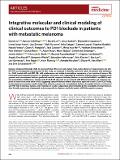| dc.contributor.author | Liu, David V. | |
| dc.contributor.author | Liu, Derek | |
| dc.contributor.author | Jerby-Arnon, Livnat | |
| dc.contributor.author | Vokes, Natalie I. | |
| dc.contributor.author | Margolis, Claire A. | |
| dc.contributor.author | Conway, Jake | |
| dc.contributor.author | He, Meng Xiao | |
| dc.contributor.author | Elmarakeby, Haitham | |
| dc.contributor.author | Dietlein, Felix | |
| dc.contributor.author | Miao, Diana | |
| dc.contributor.author | Tracy, Adam | |
| dc.contributor.author | Izar, Benjamin | |
| dc.contributor.author | Regev, Aviv | |
| dc.contributor.author | Van Allen, Eliezer M. | |
| dc.date.accessioned | 2020-06-17T18:36:59Z | |
| dc.date.available | 2020-06-17T18:36:59Z | |
| dc.date.issued | 2019-12 | |
| dc.identifier.issn | 1078-8956 | |
| dc.identifier.issn | 1546-170X | |
| dc.identifier.uri | https://hdl.handle.net/1721.1/125847 | |
| dc.description.abstract | Immune-checkpoint blockade (ICB) has demonstrated efficacy in many tumor types, but predictors of responsiveness to anti-PD1 ICB are incompletely characterized. In this study, we analyzed a clinically annotated cohort of patients with melanoma (n = 144) treated with anti-PD1 ICB, with whole-exome and whole-transcriptome sequencing of pre-treatment tumors. We found that tumor mutational burden as a predictor of response was confounded by melanoma subtype, whereas multiple novel genomic and transcriptomic features predicted selective response, including features associated with MHC-I and MHC-II antigen presentation. Furthermore, previous anti-CTLA4 ICB exposure was associated with different predictors of response compared to tumors that were naive to ICB, suggesting selective immune effects of previous exposure to anti-CTLA4 ICB. Finally, we developed parsimonious models integrating clinical, genomic and transcriptomic features to predict intrinsic resistance to anti-PD1 ICB in individual tumors, with validation in smaller independent cohorts limited by the availability of comprehensive data. Broadly, we present a framework to discover predictive features and build models of ICB therapeutic response. | en_US |
| dc.language.iso | en | |
| dc.publisher | Springer Science and Business Media LLC | en_US |
| dc.relation.isversionof | 10.1038/s41591-019-0654-5 | en_US |
| dc.rights | Creative Commons Attribution 4.0 International license | en_US |
| dc.rights.uri | https://creativecommons.org/licenses/by/4.0/ | en_US |
| dc.source | Nature | en_US |
| dc.title | Integrative molecular and clinical modeling of clinical outcomes to PD1 blockade in patients with metastatic melanoma | en_US |
| dc.type | Article | en_US |
| dc.identifier.citation | Liu, David, et al., "Integrative molecular and clinical modeling of clinical outcomes to PD1 blockade in patients with metastatic melanoma." Nature Medicine 25 (Dec. 2019): p. 1916-27 doi 10.1038/s41591-019-0654-5 ©2019 Author(s) | en_US |
| dc.contributor.department | Broad Institute of MIT and Harvard | en_US |
| dc.relation.journal | Nature Medicine | en_US |
| dc.eprint.version | Final published version | en_US |
| dc.type.uri | http://purl.org/eprint/type/JournalArticle | en_US |
| eprint.status | http://purl.org/eprint/status/PeerReviewed | en_US |
| dc.date.updated | 2020-01-28T19:15:01Z | |
| dspace.orderedauthors | David Liu ; Bastian Schilling ; Derek Liu ; Antje Sucker ; Elisabeth Livingstone ; Livnat Jerby-Amon ; Lisa Zimmer ; Ralf Gutzmer ; Imke Satzger ; Carmen Loquai ; Stephan Grabbe ; Natalie Vokes ; Claire A. Margolis ; Jake Conway ; Meng Xiao He ; Haitham Elmarakeby ; Felix Dietlein ; Diana Miao ; Adam Tracy ; Helen Gogas ; Simone M. Goldinger ; Jochen Utikal ; Christian U. Blank ; Ricarda Rauschenberg ; Dagmar von Bubnoff ; Angela Krackhardt ; Benjamin Weide ; Sebastian Haferkamp ; Felix Kiecker ; Ben Izar ; Levi Garraway ; Aviv Regev ; Keith Flaherty ; Annette Paschen ; Eliezer M. Van Allen ; Dirk Schadendorf | en_US |
| dspace.date.submission | 2020-01-28T19:15:03Z | |
| mit.journal.volume | 25 | en_US |
| mit.metadata.status | Complete | |
